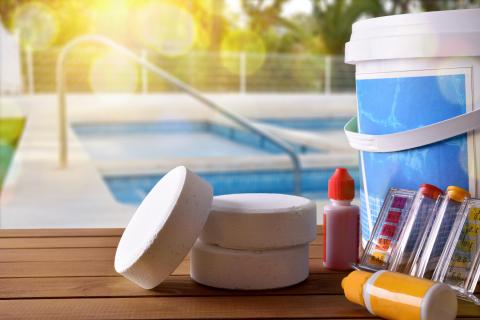Pool Chemical Safety
Every year, injuries from pool chemicals lead to emergency room visits.
Chemicals are added to pool water to kill disease-causing germs, maximize the efficacy of the disinfection process (for example, pH control), improve water quality, stop corrosion and scaling of equipment, and protect against algal growth.
However, pool chemicals can also lead to injury when mixed together or when appropriate personal protective equipment is not used during handling.
Minimize chances of injury to yourself and others
- Read and follow directions on product labels.
- Wear appropriate safety equipment, such as goggles and masks, as directed, when handling pool chemicals.
- Secure pool chemicals to protect people and animals.
- Keep young children away when handling chemicals.
- NEVER mix different pool chemicals with each other, especially chlorine products with acid.
- Pre-dissolve pool chemicals ONLY when directed by product label.
- Add pool chemical to water, NEVER water to pool chemicals.
Be aware. Check the free chlorine level and pH before getting into the water:
| Pool Type | Ratio of Chemicals to Water |
|---|---|
| Pools | Proper free chlorine level (1 mg/L or parts per million [ppm]) pH (7.2-7.8) maximize germ-killing power. |
| Hot tubs/spas | Proper disinfectant level (chlorine [3 ppm] or bromine [5 ppm] pH [7.2-7.8]) maximize germ-killing power. |
Most superstores, hardware stores, and pool-supply stores sell pool test strips.
Irritants in the air at swimming pools are usually the combined chlorine byproducts of disinfection. These byproducts are the result of chlorine binding with sweat, urine, and other waste from swimmers. As the concentration of byproducts in the water increases, they move into the surrounding air as well. Breathing air loaded with irritants can cause a variety of symptoms depending on the concentration of irritants in the air and amount of time the air is breathed.
The symptoms of irritant exposure in the air can range from mild symptoms, such as coughing, to severe symptoms, such as wheezing or aggravated asthma. Promoting movement of air, getting swimmers to shower before getting in the pool, and promoting regular bathroom use can decrease the formation of irritants.
Public swimming pools and water attractions are licensed and inspected by the Wisconsin Department of Agriculture, Trade, and Consumer Protection (DATCP).
More information on the following topics can be found on the DATCP Public Swimming Pools website:
- How to obtain or maintain a public pool license
- DATCP Swimming Pool and Water Attraction Death, Injury, and Illness reporting forms
- DATCP Water Quality Standards fact sheet
- DATCP Monthly Reports on Swimming Pool Operation (logs)
- DATCP Fecal Incident Response Reports
- CDC: Healthy Swimming – Fecal Incident Response Recommendations for Aquatic Staff (PDF)
- DATCP Approved water test kits


